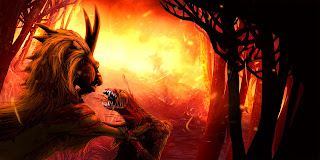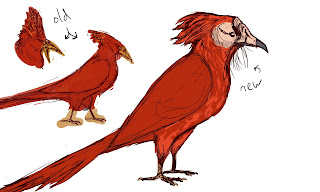Since my last update I have been working on creating an artbook for my final project, bringing together all the elements I have picked up from previous experiments to develop a world populated by a number of creatures. I had fully intended to make a post during the middle to show the process, but I kept pushing it aside in order to concentrate on whatever part I was working on that day.
My book consists of three parts. The first looks at past experiments from this year, explaining a little about them and what I learnt about from their completion. It ends with a page of final thoughts, and a conclusion drawn about the best practice approach. Essentially, it states that learning and branching out as much as possible allows you to find things that work for your own subjective tastes, and this grants you confidence in your work in order to do better. I found that simply
doing is better than over-analysing or aiming for perfection, as it allowed for failure or successes to be worked through and learnt from, whatever happens.
The second part introduced the world, a land scarred by valleys and extreme seasons. Gunpowder doesn't exist, so weapons are restricted to bows and blades. Mounts are used for this reason, giant Rocs and Talians (a large cat-like breed) that work alongside man in savannah cities. I completed a few environments and spoke about the process, including the use of clay models for any animals in the scene.


I also developed three characters (alongside an animal companion) who were the major players within the world's plot. Humans and environments were not a strength of mine, but working on the latter over the course of this year encouraged me to try to combat my other weakness. While I would not claim any proficiency in their designing, I am much happier to try than I was before. I learnt a lot from their design process and although it took a long time to complete them (and pushed my book timings out of whack a little bit, forcing more intricate time management) I am quite pleased with the result, and am looking forwards to working on this part of my skill-set in the future.

The final and largest section of my book was obviously the creature designs. It begins with four watercolour studies of the main animal types - mammals (primarily small, since I hadn't drawn them before), cold-blooded (reptiles, amphibians, fish), insects, and birds. These were done to learn the shape language of the creature group and create a few small animals to flesh out the world, rather than only concentrating on the big animals. It was a technique I picked up in previous experiments and definitely helps me to learn a shape or form more than digital would.

After the studies come several pages worth of small animals. Ten birds, eight insects, eight coldbloodeds, and thirteen little mammals. Each is named and has a small amount of text about their place in the world. Some of them have relationships with one another, such as Springbud insects gathering on the Vinbower snake in order to add to its camouflage, in return for protection from birds that would eat them. These small animals gave more credence to the world and its predators, granting them something to hunt and altering my perception of them into a more realistic and developed form. The horned dog, Rykos, became a more playful and wide-ranging hunter due to the influx of small animals that it could chase, even if it didn't always intend to catch them.

Beyond the studies came the main content; sketches and information about a number of big creatures. It falls in a simple layout. Each has small sketches of the main inspiration for the animal, and others that might have influenced an aspect of its design. Below that are sketches (traditional (scanned), or digital) and some text about how the design went, whether it was difficult or fun, and what I learnt from the process.
On the right page is a front and side orthographic of the creature in flat colours, which were extremely useful to create as front views tended to be something I would avoid. It really gave a better picture of the animal, and added to each one's character. Beneath this is red text giving a flavour of the animal in its environment, how people in the world might react to it, and how it interacts with other species, Below that comes black text that explains design points in a more detailed manner, such as the male Talian having large lung capacity with which to dive in savannah lakes, where its bulk is less of an obstacle than it would be on land.




The book took long to complete than I anticipated. The human characters over-ran, as I wasn't happy with their design for a long time, and one of the environments (which eventually ended up being put aside in favour of finalising other parts of the book) took an incredibly long time to develop, especially the model part of it and then the integration of said model into the image. It was a learning curve, and I picked up how to better balance the two halves of an image from working with it.
Within the book, I concluded my research into the best practice approach. Essentially, I decided, it depends on the person. You can learn from tutorials and observation and such, but you need the motivation to continue through mistakes and difficulty, and determination to learn from any source, even if it leads to a dead end and doesn't influence your art style in the long run. I'm sure that the best practice approach is mental, rather than a physical method of working (which I had initially expected at the beginning of this entire project), since actual art styles are subjective and dependent on the person. The willingness to learn just from the process of
doing was my main take-away, and I have undertaken a few minor pieces in this space between book completion and final hand-in, in order to challenge myself further with what I can learn.
















